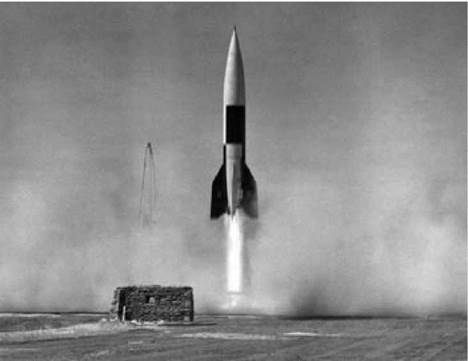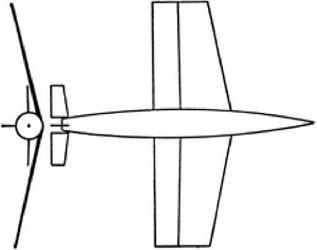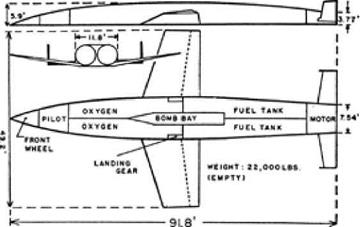Introduction
As an approach to the concept of hypersonic flight, one may begin by thinking of a sequence of high-performing aircraft that have flown at successively higher speeds. At Mach 2, twice the speed of sound, typical examples included the F-104 fighter and the Concorde commercial airliner. Though dramatically rakish in appearance, they were built of aluminum, the most familiar of materials, and used afterburning turbojets for propulsion.1
At Mach 3 and higher, there was the Lockheed SR-71 that cruised at 85,000 feet. The atmosphere at such altitudes, three times higher than Mount Everest, has a pressure only one-fiftieth of that at sea level. Even so, this airplane experienced aerodynamic heating that brought temperatures above 500°F over most of its surface. In turn, this heating brought requirements that dominated the problems of engineering design. Aluminum was out as a structural material; it lost strength at that high temperature. Titanium had to be used instead. Temperature-resistant fuels and lubricants also became necessary. Even so, this aircraft continued to rely on afterburning turbojets for propulsion.2
At Mach 4, the heating became still more severe and the difficulties of design were more daunting. No version of the turbojet has served at such speeds; it has been necessary to use a ramjet or rocket. The X-7, a ramjet testbed craft of the 1950s, was built of steel and had better temperature resistance than the SR-71. Still, when it flew past Mach 4.3 in 1958, the heating became so severe that it produced structural failure and a breakup of the vehicle in flight.3
Yet Mach 4 still counts as merely supersonic flight, not as hypersonic. For more than half a century analysts have defined hypersonic speeds as Mach 5 and higher.4 Only rocket-powered craft have flown so fast—and Mach 5 defines only the lower bound of the hypersonic regime. An important range of hypersonic speeds extends from Mach 20 to 25 and includes the velocities of long-range ballistic missiles and of satellites re-entering from orbit. Moreover, flight above Mach 35 was a matter of national concern during the Apollo program, for its piloted Command Module entered the atmosphere at such speeds when returning from the Moon.
Specifically, the hypersonic regime is defined as the realm of speed wherein the physics of flows is dominated by aerodynamic heating. This heating is far more intense than at speeds that are merely supersonic, even though these lesser velocities have defined the performance of the SR-71 and X-7.
Hypersonics nevertheless was a matter of practical military application before the term entered use. Germany’s wartime V-2 rocket flew above Mach 5,5 but steel proved suitable for its construction and aerodynamic heating played only a limited
role in its overall design.6 The Germans used wind-tunnel tests to ensure that this missile would remain stable in flight, but they did not view its speed regime as meriting a name of its own. Hsue-shen Tsien, an aerodynamicist at the California Institute of Technology, coined the term in 19467 Since then, it has involved three significant areas of application.
The first was the re-entry problem, which came to the forefront during the mid – 1950s. The Air Force by then was committed to developing the Atlas ICBM, which was to carry a nuclear warhead to Moscow. Left to itself, this warhead would have heated up like a meteor when it fell back into the atmosphere. It would not have burned up—it was too massive—but it certainly would have been rendered useless. Hence, it was necessary to devise a heat shield to protect it against this intense aerodynamic heating.
The successful solution to this problem opened the door to a host of other initiatives. The return of film-carrying capsules from orbit became routine, and turned strategic reconnaissance of the Soviet Union into an important element of national defense. Piloted space flight also became feasible, for astronauts now could hope to come back safely. Then, as the engineering methods for thermal protection were further improved, thoughts of a space shuttle began to flourish. They took shape as a reusable launch vehicle, the first of its kind.
Hypersonic technologies also became important as policy makers looked ahead to an era in which the speed and performance of fighters and bombers might increase without limit. This expectation led to the X-15. Though designed during the 1950s, this rocket-powered research airplane set speed and altitude marks that were not surpassed until the advent of the shuttle. Aerodynamic heating again defined its design requirements, and it was built of the nickel alloy Inconel X. It routinely withstood temperatures of 1200°F as it flew to Mach 6,8 and reached altitudes high enough for some of its pilots to qualify as astronauts.
Only rocket engines could propel a vehicle at such speeds, but hypersonic propulsion has represented a third important area of application. Here the hope has persisted that innovative airbreathing engines—scramjets—might cope with intense aerodynamic heating while offering fuel economy far surpassing that of a rocket. Other work has emphasized airbreathing rockets, which could give improved performance by eliminating the need to carry liquid oxygen in a tank. These concepts have held their own importance. They lay behind the National Aerospace Plane (NASP) program of 1985-1995, which sought to lay groundwork for single-stage vehicles that were to use both types of engine and were to fly from a runway to orbit.
The Air Force historian Richard Hallion has written of a “hypersonic revolution,” as if to place the pertinent technologies on par with the turbojet and liquid – propellant rocket.9 The present book takes a more measured view. "Work in hyper – sonics had indeed brought full success in the area of re-entry. Consequences have included strategic missiles, the Soviet and American man-in-space programs, the
Corona program in strategic reconnaissance, Apollo, and the space shuttle. These activities deterred nuclear war, gained accurate estimates of the Soviet threat, sent astronauts to the Moon and brought them home, and flew to and from space in a reusable launch vehicle. This list covers many of the main activities of the postwar missile and space industry, and supports Hallions viewpoint.
But in pursuing technical revolution, engineers succeed in actually solving their problems, as when the Apollo program sent men to the Moon. These people do not merely display brilliant ingenuity while falling short of success. Unfortunately, the latter has been the case in the important area of hypersonic propulsion.
The focus has involved the scramjet as a new engine. It has taken form as a prime mover in its own right, capable of standing alongside such engines as the turboprop and ramjet. Still, far more so than the other engines, the scramjet has remained in the realm of experiment. Turboprops powered the Lockheed Electra airliner, P-3 antisubmarine aircraft, and C-130 transport. Ramjets provided propulsion for the successful Bomarc and Talos antiaircraft missiles. But the scramjet has powered only such small experimental airplanes as the X-43A.
Why? From the outset, the scramjet has faced overwhelming competition from a successful alternative: the rocket. This has strongly inhibited funding and has delayed its development to a point at which it could be considered seriously. On paper, scramjets offer superior performance. They therefore drew attention in the mid-1980s, during the heyday of NASP, at a time when Air Force officials had become disenchanted with the space shuttle but faced huge prospective demand for access to space in President Reagans Strategic Defense Initiative. For once, then, scramjets gained funding that served to push their development—and their performance fell well short of peoples hopes.
Within this book, Chapter 1 covers the immediate postwar years, when America still had much to learn from the Europeans. It focuses on two individuals: Eugen Sanger, who gave the first proposal for a hypersonic bomber, and John Becker, who built Americas first hypersonic wind tunnel.
Chapter 2 covers the first important area of hypersonic research and development, which supported the advent of strategic missiles during the 1950s. The focus was on solving the re-entry problem, and this chapter follows the story through flight tests of complete nose cones.
Chapter 3 deals with the X-15, which took shape at a time when virtually the whole of Americas capability in hypersonics research was contained within Beckers 11-inch instrument. Today it is hard to believe that so bold and so successful a step in aviation research could stand on so slender a foundation. This chapter shows how it happened.
Chapter 4 introduces hypersonic propulsion and emphasizes the work of Antonio Ferri, an Italian aerodynamicist who was the first to give a credible concept for a scramjet engine. This chapter also surveys Aerospaceplane, a little-known program of
paper studies that investigated the feasibility of flight to orbit using such engines.
The next two chapters cover important developments in re-entry that followed the ICBM. Chapter 5, “Widening Prospects for Re-Entry,” shows how work in this area supported the manned space program while failing to offer a rationale for a winged spacecraft, Dyna-Soar. Chapter 6, “Hypersonics and the Shuttle,” begins by outlining developments during the mid-1960s that made it plausible that NASA’s reusable space transporter would be designed as a lifting body and built using hot structures. In fact, the shuttle orbiter came forth as a conventional airplane with delta wings, and was built with aluminum structure covered with thermal-protecting tiles. This discussion indicates how those things happened.
Chapter 7, “The Fading, the Comeback,” shows how work with scramjets did not share the priority afforded to the topic of re-entry. Instead it faded, and by the late 1960s only NASA-Langley was still pursuing studies in this area. This ongoing effort nevertheless gave important background to the National Aerospace Plane— but it was not technical success that won approval for NASP As noted, it was the Strategic Defense Initiative. Within the Strategic Defense Initiative, the scramjet amounted to a rabbit being pulled from a hat, to satisfy Air Force needs. NASP was not well-founded at the outset; it was more of a leap of faith.
Chapter 8, “Why NASP Fell Short,” explains what happened. In summary, the estimated performance of its scramjet engine fell well below initial hopes, while the drag was higher than expected. Computational aerodynamics failed to give accurate estimates in critical technical areas. The ejector ramjet, a key element of the propulsion system, proved to lack the desired performance. In the area of materials, metallurgists scored an impressive success with a new type of titanium called Beta-21 S. It had only half the density of the superalloys that had been slated for Dyna-Soar, but even greater weight savings would have been needed for NASP.
Finally, Chapter 9 discusses “Hypersonics After NASP.” Recent developments include the X-33 and X-34 launch vehicles, which represent continuing attempts to build the next launch vehicle. Scramjets have lately taken flight, not only as NASA’s X-43A but also in Russia and in Australia. In addition, the new topic of Large Eddy Simulation, in computational fluid mechanics, raises the prospect that analysts indeed may learn, at least on paper, just how good a scramjet may be.
What, in the end, can we conclude? During the past half-century, the field of hypersonics has seen three major initiatives: missile nose cones, the X-15, and NASP. Of these, only one—the X-15—reflected ongoing progress in aeronautics. The other two stemmed from advances in nuclear weaponry: the hydrogen bomb, which gave rise to the ICBM, and the prospect of an x-ray laser, which lay behind the Strategic Defense Initiative and therefore behind NASP.
This suggests that if hypersonics is to flourish anew, it will do so because of developments in the apparently unrelated field of nuclear technology.
1 F-104: Gunston, Fighters, pp. 120-126. Concorde: Heppenheimer, Turbulent, pp. 202-203, 208.
2 Crickmore, SR-71, pp. 89-91, 95-99, 194.
3 Ritchie, “Evaluation.”Steel: Miller, X-Planes, p. 119.
4 See, for example, Anderson, History, pp. 438-439.
5 Top speed of the V-2 is given as 1,600 meters per second (Dornberger, V-2, p. xix) and as 1,700 meters per second (Naval Research Laboratory, Upper, cited in Ley, Rockets, pp. 596-597); the speed of sound at the pertinent altitudes is 295 meters per second (Kuethe and Chow, Foundations, p. 518).
6 Ley Rockets, p. 243; Neufeld, Rocket, pp. 85-94.
7 Tsien, “Similarity”
8 1200°F: NASA SP-2000-4518, diagram, p. 25.
9 Hallion, Hypersonic.












 The model had “two knifelike, very thin, swept-back wings.” Mounted at its center of gravity, it “rotated at the slightest touch.” When the test began, a technician opened a valve to start the airflow. In Dornberger’s words,
The model had “two knifelike, very thin, swept-back wings.” Mounted at its center of gravity, it “rotated at the slightest touch.” When the test began, a technician opened a valve to start the airflow. In Dornberger’s words,
